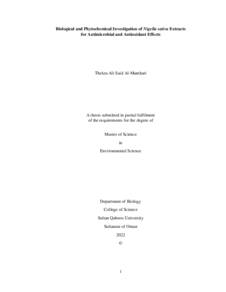Document
Biological and phytochemical investigation of Nigella sativa extracts for antimicrobial and antioxidant effects.
Publisher
Sultan Qaboos University.
Gregorian
2022
Language
English
English abstract
Pharmaceutical and scientific communities have recently focusing on medicinal plants
and various publications have documented the therapeutic effects of natural compounds
to validate the claims of their biological activity. The plant natural compounds possessing
effective antimicrobial agents since most of the pathogenic bacteria are becoming resistant
to existing synthetic antibiotics. The miracle herb selected for this study is Nigella sativa,
which has been examined for antimicrobial and antioxidant effects, phytochemical
analysis and GC-MS characterization. Five pathogenic bacteria and two fungi were
examined for antimicrobial effect. The Gram positive bacteria were Staphylococcus
aureus and Bacillus subtilis, whereas the Gram negative bacteria were Escherichia coli,
Pseudomonas aeruginosa and Salmonella typhi. The selected fungi were Aspergillus
flavus and Candida albicans. Five different solvent extracts have been prepared, which
are aqueous, ethanol, chloroform, hexane and cyclohexane. The results showed that all
the extracts, except aqueous, were able to inhibit the microbial growth with an inhibition
zone as high as (20.6 ± 0.5 and 20.5 ± 0.5 mm) for E. coli and S. aureus respectively. In
addition, all the extracts were showed antioxidant effects at varied concentrations. As a
result of the phytochemical analysis and GCMS characterization, the extracts were
contained a wide range of phytochemical constituents and bioactive compounds
responsible for antimicrobial and antioxidant effects. The findings of the study revealed
that the N. sativa plant has potential phytoconstituents which stimulate its biological
activities, therefore this experimental plant can be further assayed for pharmacological
preparations.
Member of
Resource URL
Arabic abstract
ركزت المجتمعات الدوائية والعلمية مؤخرا على النباتات الطبية ووثقت المنشورات المختلفة الآثار العالجية للمركبات الطبيعية للتحقق من صحة مزاعم نشاطها البيولوجي. تحتوي المركبات الطبيعية النباتية على عوامل فعالة مضادة للميكروبات ألن معظم البكتيريا المسببة للأمرض أصبحت مقاومة للمضادات الحيوية الاصطناعية الموجودة. النبتة المعجزة التي تم اختيارها لهذه الدراسة هي حبة البركة ، والتي تم فحصها من أجل التأثيرات المضادة للميكروبات ومضادات الاكسدة ، والتحليل الكيميائي النباتي وتوصيف MS-GC. تم فحص خمسة أنواع من البكتيريا المسببة للأمرض واثنين من الفطريات لمعرفة تأثيرها كمضاد للميكروبات. كانت البكتيريا موجبة الجرام هي aureus Staphylococcus و subtilis Bacillus ، بينما كانت البكتيريا سالبة الجرام هي coli Escherichia و aeruginosa Pseudomonas و typhi Salmonella. الفطريات المختارة كانت flavus Aspergillus و albicans Candida.تم تحضير خمسة مستخلصات مذيبات مختلفة وهي الماء، إيثانول، كلوروفورم، هكسان، وسيكلوهكسان. أظهرت النتائج أن جميع المستخلصات - باستثناء المائي - كانت قادرة على تثبيط نمو الميكروبات بمنطقة تثبيط تصل إلى )20.6 ± 0.5 و 20.5 ± 0.5 مم( ل coli .E و aureus .S على التوالي. بالاضافة إلى ذلك، أظهرت جميع المستخلصات تأثيرات مضادة للأكسدة بتركيزات مختلفة. نتيجة للتحليل الكيميائي النباتي وتوصيف GCMS، احتوت المستخلصات على مجموعة واسعة من المكونات الكيميائية النباتية والمركبات النشطة بيولوجيًا المسؤولة عن التأثيرات المضادة للميكروبات ومضادات الاكسدة. كشفت نتائج الدراسة أن نبات حبة البركة يحتوي على مكونات نباتية محتملة تحفز أنشطته البيولوجية، وبالتالي يمكن إجراء اختبار إضافي لهذا النبات التجريبي من أجل المستحضرات الدوائية.
Category
Theses and Dissertations

